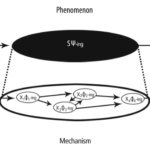system design
now browsing by tag
Mechanism of operation vs. system model

Most often in the course of analysis we use the term model, less often mechanism. The thing is that the term mechanism appears when we want to explain something, e.g. “the mechanism of generating a discount on an invoice”. The thing is that the term mechanism appears when we want to explain something, e.g. “the mechanism for generating a discount on an invoice”. But here beware! A model (block diagrams, formulae, etc.) is documentation, a copyrighted description. The mechanism is what we understood by reading these documentation (model), because the mechanism is protected know-how. The content of the application to the Patent Office is the model (description), but what we patent is the mechanism invented/developed.
Source: Mechanism of operation vs. system model – Jarosław Żeliński IT-Consulting
Ontology-Oriented Data Management and Document Databases

This study presents a method for the storage of data organized in digital documents, which is proven in practice. The discussed method does not bear any disadvantages of the relational model used for data organization, such as the loss of data context and complications evoked by the lack of data redundancy. The method presented here can be used for data organization into documents (digital and paper) as classified aggregates and for data classification. The study also describes a new metamodel for the data structure which assumes that documents, being data structures, form compact aggregates, classified as objects, or event descriptions, thus always assigning them a specific and unambiguous context. Furthermore, the study presents a design method for documents as context aggregates that allows leveling the disadvantages of the relational model and ensures efficient information management. The work also contains practical examples of the application of the described method.
Digital Documents as Data Carriers and a Method of Data Management Guaranteeing the Unambiguity of the Recorded Information: Ontology-Oriented Data Management and Document Databases
Systems analysis and design

Many time we heard about agile in software development. Many times authors wrote that agile provide us to fast and cheapest solutions. It is true but not all the times. Chaos Report (see Standish Group) show us, that is not true all the times.
Few comments…
Generally small projects are not a (big) problem..

Waterfall vs. agile: first one method consume many more time than second one, but we have no time to ‘big analysis’. Second one mean ‘working too fast’, and effect is more prototyping mean cost increasing… many time mean: cancel project before finish caused by budget:

A waterfall is not a solution, but agile is not a good remedy for it. A common problem in software design is system size and complexity:

How to improve quality and chance to succeed software project? We need really good person to business analysis role and only one. More than one person in a first stage, mean more problem with merging parts to one completed and unambiguous requirements document :

Disciplined agile, what is it? Using models in agile, why and for what? Modern system analysis and design is not a waterfall and not a agile style? It is science method used for software engineering . Discover the MDA and patterns as a wand for your success in software projects. See the system as a architecture .
More about general systems and SysML notation coming soon ?
Try my courses for improve your skills and your teammates, hire me as a gifted person in your project.
